MSI X79A-GD45 Plus Review: Building Up
by Ian Cutress on February 14, 2014 10:00 AM EST- Posted in
- Motherboards
- Intel
- MSI
- X79
Real World CPU Benchmarks
Readers of our motherboard review section will have noted the trend in modern motherboards to implement a form of MultiCore Enhancement / Acceleration / Turbo (read our report here) on their motherboards. This does several things – better benchmark results at stock settings (not entirely needed if overclocking is an end-user goal), at the expense of heat and temperature, but also gives in essence an automatic overclock which may be against what the user wants. Our testing methodology is ‘out-of-the-box’, with the latest public BIOS installed and XMP enabled, and thus subject to the whims of this feature. It is ultimately up to the motherboard manufacturer to take this risk – and manufacturers taking risks in the setup is something they do on every product (think C-state settings, USB priority, DPC Latency / monitoring priority, memory subtimings at JEDEC). Processor speed change is part of that risk which is clearly visible, and ultimately if no overclocking is planned, some motherboards will affect how fast that shiny new processor goes and can be an important factor in the purchase.
For reference, the MSI X79A-GD45 does enable MCT when XMP is enabled.
Rendering – Adobe After Effects CS6: link
Published by Adobe, After Effects is a digital motion graphics, visual effects and compositing software package used in the post-production process of filmmaking and television production. For our benchmark we downloaded a common scene in use on the AE forums for benchmarks and placed it under our own circumstances for a repeatable benchmark. We generate 152 frames of the scene and present the time to do so based purely on CPU calculations.

Compression – WinRAR 5.0.1: link
Our WinRAR test from 2013 is updated to the latest version of WinRAR at the start of 2014. We compress a set of 2867 files across 320 folders totaling 1.52 GB in size – 95% of these files are small typical website files, and the rest (90% of the size) are small 30 second 720p videos.
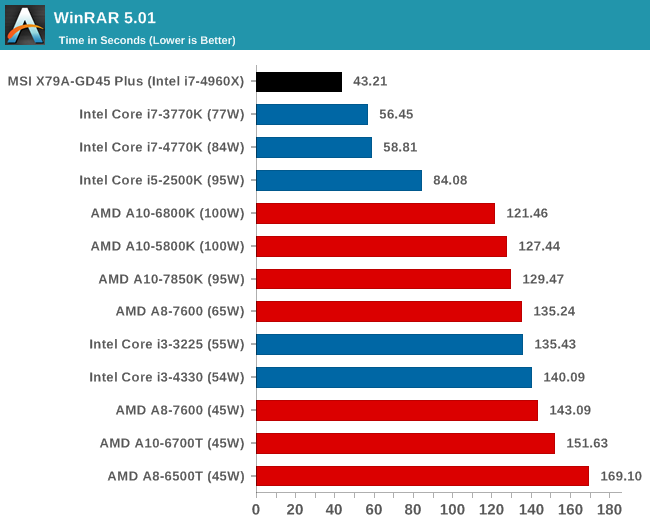
Image Manipulation – FastStone Image Viewer 4.9: link
Similarly to WinRAR, the FastStone test us updated for 2014 to the latest version. FastStone is the program I use to perform quick or bulk actions on images, such as resizing, adjusting for color and cropping. In our test we take a series of 170 images in various sizes and formats and convert them all into 640x480 .gif files, maintaining the aspect ratio. FastStone does not use multithreading for this test, and thus single threaded performance is often the winner.
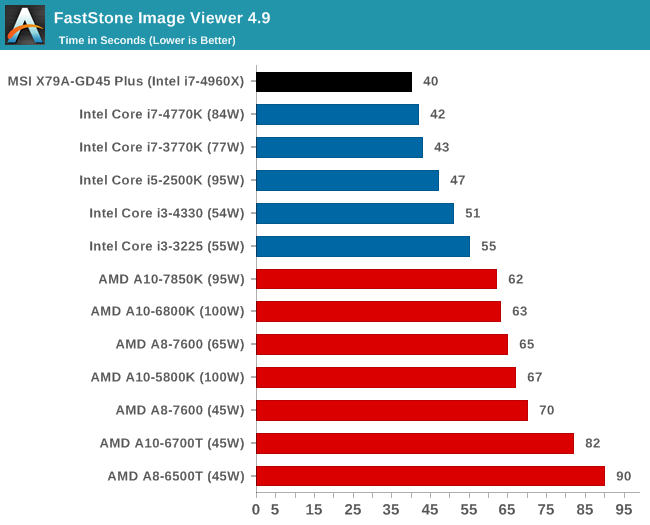
Video Conversion – Xilisoft Video Converter 7: link
The XVC test I normally do is updated to the full version of the software, and this time a different test as well. Here we take two different videos: a double UHD (3840x4320) clip of 10 minutes and a 640x266 DVD rip of a 2h20 film and convert both to iPod suitable formats. The reasoning here is simple – when frames are small enough to fit into memory, the algorithm has more chance to apply work between threads and process the video quicker. Results shown are in seconds and time taken to encode.
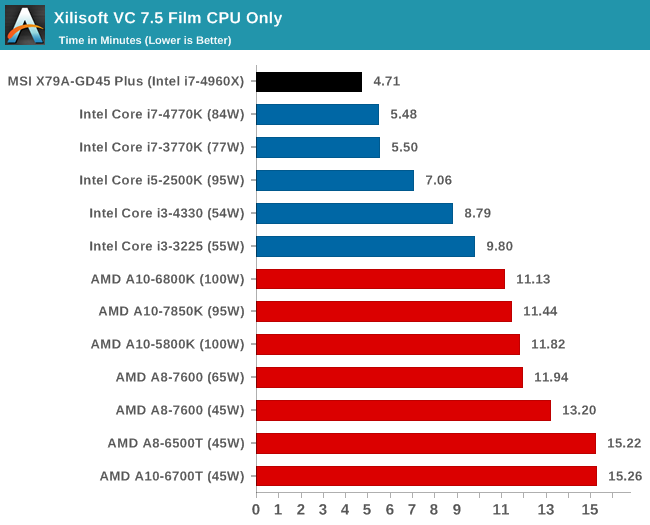
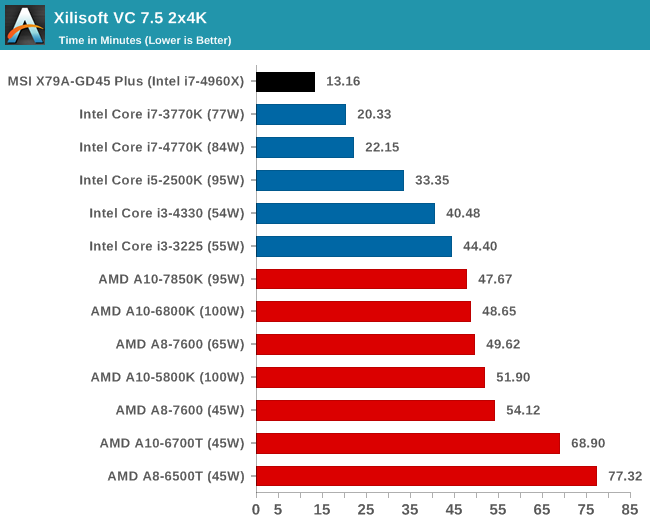
Video Conversion – Handbrake v0.9.9: link
Handbrake is a media conversion tool that was initially designed to help DVD ISOs and Video CDs into more common video formats. The principle today is still the same, primarily as an output for H.264 + AAC/MP3 audio within an MKV container. In our test we use the same videos as in the Xilisoft test, and results are given in frames per second.
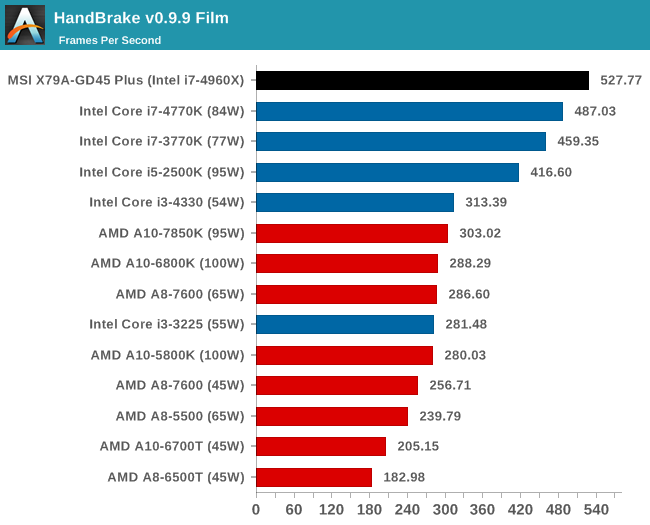
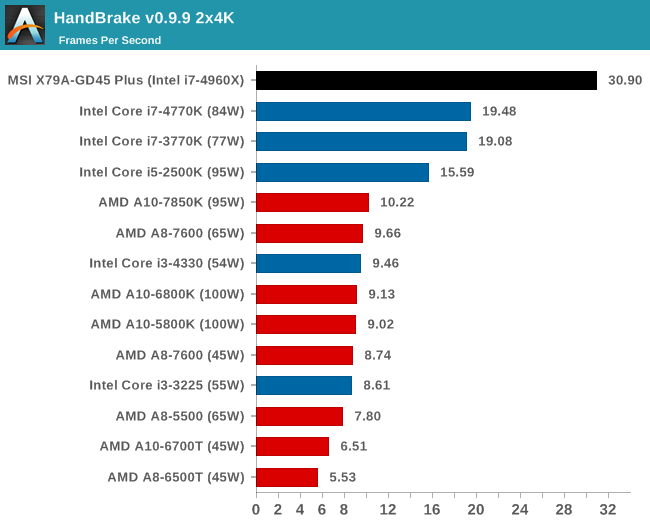
Rendering – PovRay 3.7: link
The Persistence of Vision RayTracer, or PovRay, is a freeware package for as the name suggests, ray tracing. It is a pure renderer, rather than modeling software, but the latest beta version contains a handy benchmark for stressing all processing threads on a platform. We have been using this test in motherboard reviews to test memory stability at various CPU speeds to good effect – if it passes the test, the IMC in the CPU is stable for a given CPU speed. As a CPU test, it runs for approximately 2-3 minutes on high end platforms.
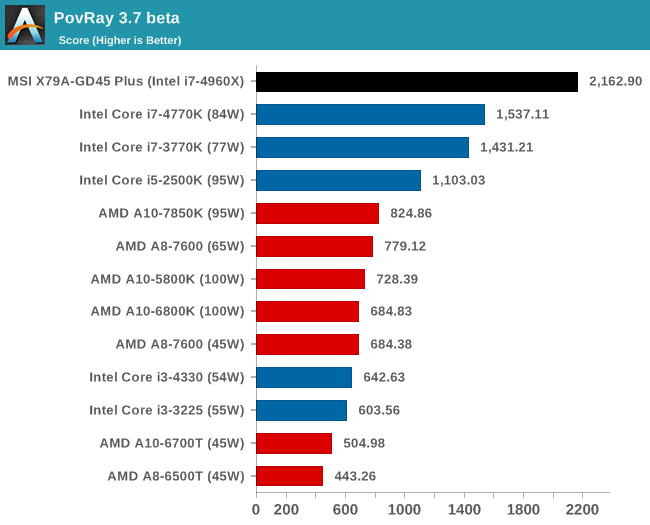










44 Comments
View All Comments
chuonglb - Thursday, March 6, 2014 - link
goodkizi: http://www.kizi10games.net
friv: http://www.friv200jogos.org
yepi: http://www.yepi10games.org
The PC Apologist - Saturday, February 15, 2014 - link
1) How many times have you seen me in the comments?2) Is complaining about poor English or bad grammar inherently bad?
3) Are my complaints illegitimate/inappropriate (calling good grammar bad)?
4) Do you come to this site expecting a pep talk or a well-written article?
5) Does you loathing me count towards the calculus of anything?
Thank you.
Ian Cutress - Friday, February 14, 2014 - link
Commonly people like to point out that I refer to companies using plural terms, as is the standard in the UK and persistent throughout my UK upbringing. No matter how hard I try and convert into singular style common in the US, it requires a complete reworking of my brain which I cannot do on the fly. So any attempt to try and patch the difference ends up half-baked, as it were.If you have specific suggestions, feel free to email by clicking on my name at the top of the article.
Ian
The PC Apologist - Friday, February 14, 2014 - link
No worries Ian.I appreciate the candor and sincerity. It’s nice to know that you’re open enough for constructive criticism and room for improvement, which can’t be said for everybody. But as far as writing goes, I suspect that the problem lies beyond just the confusion of singular vs. plural. Such can just be attributed to carelessness and be called honest mistakes. Rather, sometimes, there seems to be a lack of deeper substance and coherent flow. Other times, the language is simply not “beautiful,” but rather mundane and unenthused.
But like I said, for the time being, no worries. What’s important is that you’re open to suggestion and change. Writing is, among other things, an art, and it’s rather difficult to codify the formula for success. But with the correct attitude, one will eventually evolve and improve with practice, lots of reading (of good writers), and rigorous analytical thinking.
- The PC Apologist
Nfarce - Sunday, February 16, 2014 - link
PCA - just go start your own blog and STFU. We don't need your distractions, pompous jerkwad.khanov - Friday, February 14, 2014 - link
I think you are used to reading 'Americanese'. There is nothing wrong with Ian's English.The PC Apologist - Friday, February 14, 2014 - link
I think you are used to being "nice." There is nothing wrong with being honest from time to time.DMCalloway - Friday, February 14, 2014 - link
Unfortunately, the i7 2600k wasn't included in the benchmarks. This would have given the reader a clear overview of 2nd, 3rd, and 4th generation i7 performance for comparison.Ian Cutress - Friday, February 14, 2014 - link
Most of the results from other processors were derived from the retest required for the 2014 benchmark suite, initiated by the AMD Kaveri review. In time I will be going back and testing older CPUs when the backlog of review hardware falls to a reasonable level.The_Assimilator - Saturday, February 15, 2014 - link
Can you guys please start deducting points for motherboards that still include COM headers?